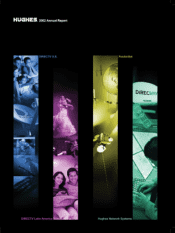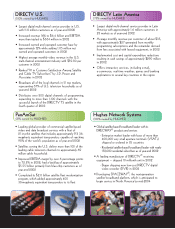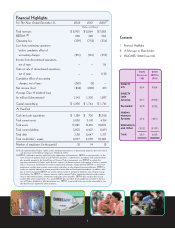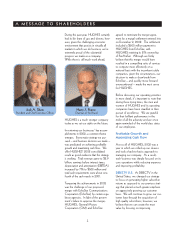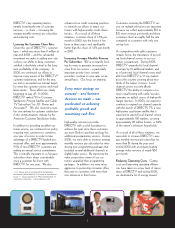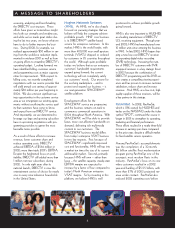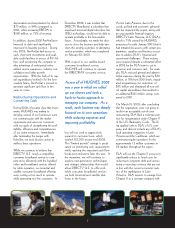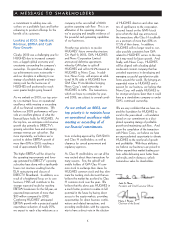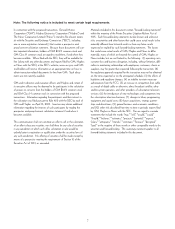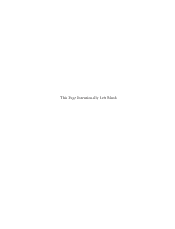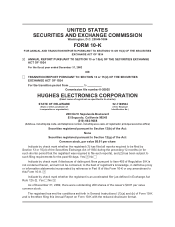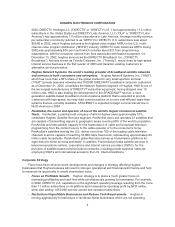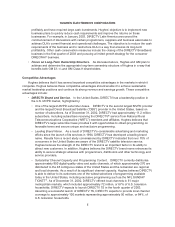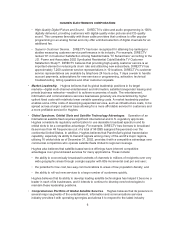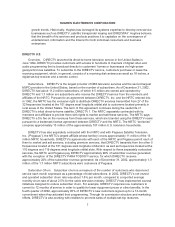DIRECTV 2002 Annual Report Download - page 7
Download and view the complete annual report
Please find page 7 of the 2002 DIRECTV annual report below. You can navigate through the pages in the report by either clicking on the pages listed below, or by using the keyword search tool below to find specific information within the annual report.
5
depreciation and amortization by almost
$70 million, or 24% compared to
2001, while increasing EBITDA to
$592 million, or 73% of revenue.
In addition, during 2002 PanAmSat re-
financed its debt and significantly
improved its liquidity position. Going
into 2003, PanAmSat had access to
cash, short term investments and avail-
able credit facilities in excess of $1.1 bil-
lion, well positioning the company to
take advantage of anticipated value-
added service expansion, industry con-
solidation and other growth
opportunities. With the bulk of its cap-
ital expenditures behind it for the fore-
seeable future, PanAmSat is poised to
generate significant cash flow in the
years to come.
Restructuring Operations and
Conserving Cash
During 2002, it became clear that invest-
ments HUGHES was making to
develop several of our businesses were
not commensurate with the market
opportunity and were not consistent
with our goals of strengthening the prof-
itability, efficiency and competitiveness
of our entire enterprise. Immediately
after terminating the merger with
EchoStar, we took decisive action to
address these operations.
While we continue to believe that
DIRECTV U.S. needs a compelling
consumer broadband service to com-
pete more effectively with the bundled
video and broadband services offered
by cable operators, our terrestrial and
satellite consumer broadband offerings
were costing us too much to operate
while generating too few customers. In
December 2002, it was evident that
DIRECTV Broadband, a subsidiary that
employed terrestrial digital subscriber line
(DSL) technology, would not be able to
operate profitably in the foreseeable
future. Accordingly, we made the deci-
sion to close the business and help tran-
sition the existing customers to alternative
service providers, which was completed
on February 28, 2003.
With respect to our satellite-based
consumer broadband service,
HUGHES will continue to operate
the DIRECWAY consumer service,
but will not seek to aggressively
expand its customer base, which
totaled 158,000 at year-end 2002.
This “limited growth” strategy is predi-
cated on minimizing cash requirements
while reaching the important cash flow
break-even milestone later this year. In
the meantime, we will continue to
explore next-generation technologies
and strategic relationships that would
allow DIRECTV U.S. to offer prof-
itable consumer broadband services
via both terrestrial and satellite plat-
forms in the future.
And in Latin America, due to the
social, political and economic upheaval
that has impacted the region, along with
an unacceptable financial situation,
DIRECTV Latin America, LLC (DLA),
which is 75% owned by HUGHES,
announced in early January 2003 that it
had initiated discussions with certain pro-
grammers, suppliers and business associ-
ates to address DLA’s financial and
operational challenges. These actions
were required despite a substantial effort
in 2002 by the DLA team to cut its
expenses and conserve cash. For exam-
ple, DLA reduced general and adminis-
trative expenses during the year by $50
million, or 18% from 2001 levels, negoti-
ated programming cost reductions of
$95 million and eliminated all non-criti-
cal capital expenditures that resulted in
an additional $145 million savings com-
pared to 2001.
On March 18, 2003, after concluding
that the negotiations were not going to
result in an acceptable out-of-court
restructuring, DLA filed a voluntary peti-
tion for reorganization under Chapter 11
of the U.S. Bankruptcy Code. The fil-
ing applied only to DLA, a U.S. com-
pany, and did not include any of DLA’s
local operating companies in Latin
America and the Caribbean, which are
continuing regular operations for the
approximately 1.5 million customers in
28 markets throughout the region.
DLA will use the Chapter 11 process to
significantly reduce its fixed costs by
reducing its long-term debt and restruc-
turing or rejecting contracts that are not
in line with the current economic reali-
ties of the marketplace in Latin
America. DLA expects to emerge from
Chapter 11 as a stronger company with
Across all of HUGHES, 2002
was a year in which we rolled
up our sleeves and took a
back-to-basics approach to
managing our company. As a
result, each business was sharply
focused on its core operations
while reducing expenses and
improving profitability

